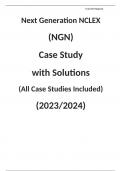Tutor3570@gmail
Next Generation NCLEX
(NGN)
Case Study
with Solutions
(All Case Studies Included)
(2023/2024)
, Tutor3570@gmail
Next Generation NCLEX (NGN) Case Study
Case Study:
Patient Profile:
Jane Smith, a 32-year-old female, presents to the emergency department with
complaints of severe abdominal pain, nausea, and vomiting. She has a medical
history of cholecystitis and a previous cholecystectomy. She reports that the pain
started in the right upper quadrant and has since radiated to her right shoulder. She
denies any recent trauma or illness.
Assessment Findings:
Vital signs: Blood pressure 130/80 mmHg, heart rate 90 bpm, respiratory rate 18
bpm, temperature 37.2°C (99°F)
Abdominal examination reveals tenderness in the right upper quadrant with
guarding
Laboratory results:
Complete blood count: WBC 14,000/mm³, hemoglobin 13.5 g/dL, hematocrit 40%
Liver function tests: Elevated levels of AST, ALT, and total bilirubin
Amylase and lipase levels within normal range
Diagnosis:
Based on the patient's symptoms, history of cholecystitis, and physical examination
findings, the nurse suspects acute pancreatitis.
Plan of Care:
Pain management:
Administer analgesics as prescribed, such as intravenous morphine, to alleviate pain
and promote patient comfort.
, Tutor3570@gmail
Assess pain levels regularly using a pain scale and adjust medication dosages
accordingly.
Monitor for any adverse effects of pain medications, such as respiratory depression
or sedation.
Nausea and vomiting management:
Administer antiemetic medications, such as ondansetron, to control nausea and
vomiting.
Encourage the patient to avoid oral intake until nausea subsides to prevent further
discomfort and potential exacerbation of symptoms.
Provide frequent oral hygiene to relieve dry mouth and promote patient comfort.
Monitoring and supportive measures:
Monitor vital signs regularly, including temperature, heart rate, blood pressure, and
respiratory rate, to assess for any signs of deterioration or complications. Maintain
strict intake and output records to monitor fluid balance and detect any signs of
dehydration.
Insert a nasogastric tube if necessary to decompress the stomach and relieve
gastrointestinal symptoms.
NPO (nothing by mouth) and bowel rest:
Maintain the patient on NPO status to allow the pancreas to rest and reduce
pancreatic secretions.
Provide intravenous fluids and electrolyte replacement as prescribed to maintain
hydration and electrolyte balance.
Collaborate with the healthcare team to determine the optimal timing for resuming
oral intake based on the patient's clinical progress.
Education and discharge planning:
Provide the patient with information about acute pancreatitis, including its causes,
symptoms, and risk factors.
, Tutor3570@gmail
Discuss the importance of adherence to a low-fat diet and abstinence from alcohol
to prevent future episodes of pancreatitis.
Arrange for follow-up appointments with the healthcare provider to monitor the
patient's progress and adjust the treatment plan if necessary.
Solution:
The patient's symptoms, history, and assessment findings indicate acute
pancreatitis. The nurse's plan of care focuses on pain management, nausea and
vomiting control, monitoring and supportive measures, NPO status and bowel rest,
as well as patient education and discharge planning.
By effectively managing the patient's pain, the nurse can enhance comfort and
facilitate recovery. Regular assessment of pain levels and adjustment of analgesics
accordingly are essential to meet the patient's individual needs. Concurrently,
antiemetic medications help alleviate nausea and vomiting, promoting patient
comfort and minimizing the risk of dehydration.
Close monitoring of vital signs, fluid balance, and electrolyte levels is crucial for early
detection of complications and to ensure appropriate interventions. Maintaining the
patient on NPO status and providing intravenous Case Study:
Patient Profile:
John Davis, a 45-year-old male, is admitted to the hospital with a chief complaint of
shortness of breath and chest pain. He has a medical history of hypertension,
hyperlipidemia, and obesity. He is a smoker and admits to occasionally skipping his
medications. He reports experiencing increased fatigue and decreased exercise
tolerance over the past month.
Assessment Findings:
Vital signs: Blood pressure 160/90 mmHg, heart rate 100 bpm, respiratory rate 20
bpm, temperature 37.0°C (98.6°F), oxygen saturation 92% on room air




